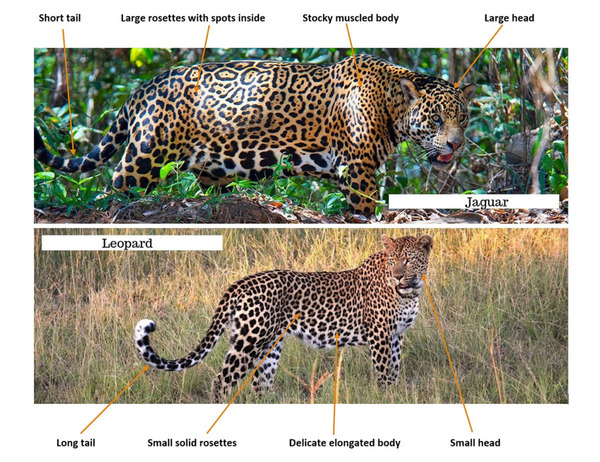Understanding the differences between jaguars and leopards can be tricky—they look similar at first glance, but these big cats have distinct characteristics. This guide dives into every detail, from their physical traits to their habitats, hunting styles, and cultural symbolism.
Physical Differences Between Jaguars and Leopards
Habitat and Geographic Distribution
Hunting Style and Strength Comparison
Jaguar vs Leopard: Who Would Win in a Fight?
Conservation Status and Threats
Cultural Symbolism of Jaguars and Leopards

At first glance, jaguars and leopards seem almost identical, but there are clear distinctions:
Size: Jaguars are generally stockier and heavier, with males weighing up to 250 pounds, while leopards are leaner and lighter, maxing out around 180 pounds.
Spots: Jaguars have larger rosettes with a dot in the center, while leopards’ spots are smaller and more densely packed.
Skull and Jaw: Jaguars have broader skulls and a stronger jaw, giving them the most powerful bite force among big cats.
These cats live on different continents and adapt to distinct environments:
Jaguars: Found in the Americas, mainly in the Amazon rainforest, jaguars prefer dense forests and water-rich environments.
Leopards: Spread across Africa and parts of Asia, leopards thrive in diverse habitats, from savannas to forests and even urban areas.
| Feature | Jaguar | Leopard |
|---|---|---|
| Location | Americas (Amazon, Pantanal) | Africa, Asia |
| Preferred Habitat | Rainforests, wetlands | Savannas, forests, mountains |
Both are apex predators, but their methods differ:
Jaguar Hunting Style: Jaguars are powerful ambush hunters. They use their strong bite to crush skulls or pierce through turtle shells.
Leopard Hunting Style: Leopards rely on stealth and agility, often dragging their prey up trees to avoid scavengers.
| Feature | Jaguar | Leopard |
|---|---|---|
| Bite Force | 1,500 psi (stronger) | 800 psi |
| Preferred Prey | Capybaras, caimans, turtles | Antelopes, monkeys, small deer |
| Hunting Technique | Skull-crushing bite | Stealth and climbing skills |
If these two big cats ever squared off, the jaguar would likely dominate due to its sheer strength and powerful bite. However, leopards are faster and more agile, which could give them an edge in evasion.
Both species face threats from habitat loss and human conflict:
Jaguars: Listed as Near Threatened due to deforestation and poaching.
Leopards: Conservation status varies by region, but many subspecies are endangered.
Conservation efforts include habitat preservation, anti-poaching laws, and community education.
Jaguars and leopards have captivated human imagination for centuries:
Jaguars: In Central and South American cultures, jaguars symbolize power and are often associated with gods or warriors.
Leopards: In African and Asian traditions, leopards are symbols of stealth, cunning, and beauty.
Despite their differences, these big cats share some traits:
Both are solitary hunters.
Both are excellent climbers and swimmers.
Both play crucial roles as apex predators in their ecosystems.
Jaguars and leopards are incredible creatures with unique traits that set them apart. Whether it’s their hunting techniques, habitats, or cultural significance, these big cats are a testament to nature’s diversity. Understanding their differences helps us appreciate their roles in the wild—and highlights the importance of conserving their habitats for future generations.
We created this article in conjunction with AI technology, then made sure it was fact-checked and edited by a Animals Top editor.